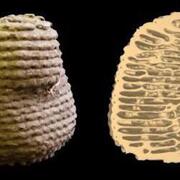
PhD candidate Alex Heyde (Mahadevan Lab) and Professor L. Mahadevan have developed a mathematical model to help explain how termites construct their intricate mounds.
The research published in the Proceedings of the National Academy of Sciences built on previous studies in the Mahadevan lab on termite mound physiology and morphogenesis. Previous research showed that day-to-night temperature variations drive convective flow in the mound that not only ventilates the colony but also move pheromone-like cues around, which trigger building behavior in termites. In this study, Heyde and Mahadevan sought to understand how termites build the intricately connected floors in individual mounds without a plan or a planner. They mapped the interior structures of two nests using CT scans, and quantified the spacing and arrangement of floors and ramps. Adding to the complexity of the nests is the fact that not only do termites build simple ramps to connect floors but they also build spiral ramps, like the ramps in parking garages, to connect multiple floors. With these visualizations and previous findings they constructed a mathematical framework to explain the layout of the mound.
"We can think of the collection of hundreds of thousands of termites as a fluid that can sense its environment and act upon it," said Heyde. "Then you have a real fluid, air, transporting pheromones through that environment, which drives new behaviors. Finally, you have mud, which is moved around by the termites, changing the way in which the pheromones flow. Our mathematical framework provided us with clear predictions for the spacing between the layers, and showed the spontaneous formation of linear and helical ramps."
In addition to partially solving the mystery of how these mounds work and are built, the research may well have implications for swarm intelligence in a range of other systems and even understanding aspects of tissue morphogenesis.
